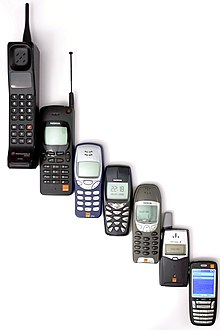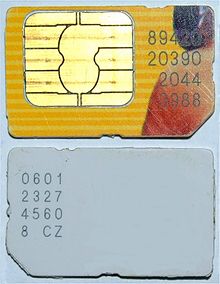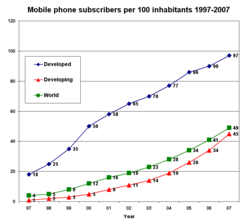History
An evolution of mobile phones
Radiophones have a long and varied history going back to Reginald Fessenden's invention and shore-to-ship demonstration of radio telephony, through the Second World War with military use of radio telephony links and civil services in the 1950s.
The first mobile telephone call made from a car occurred in St. Louis, Missouri, USA on June 17, 1946, using the Bell System's Mobile Telephone Service, but the system was impractical from what is considered a portable handset today. The equipment weighed 80 pounds (36 kg), and the AT&T service, basically a massive party line, cost US$30 per month (equal to $337.33 today) plus 30–40 cents per local call, equal to $3.37 to $4.5 today.
[4]
In 1956, the world’s first partly
automatic car phone system, Mobile System A (MTA), was launched in Sweden. MTA phones were composed of vacuum tubes and relays, and had a weight of 40 kg. In 1962, a more modern version called
Mobile System B (MTB) was launched, which was a push-button telephone, and which used transistors to enhance the telephone’s calling capacity and improve its operational reliability, thereby reducing the weight of the apparatus to 10 kg. In 1971, the MTD version was launched, opening for several different brands of equipment and gaining commercial success.
Example of an early fixed phone
Martin Cooper, a Motorola researcher and executive is considered to be the inventor of the first practical mobile phone for
handheld use in a non-vehicle setting, after a long race against Bell Labs for the first portable mobile phone. Using a modern, if somewhat heavy portable handset, Cooper made the first call on a handheld mobile phone on April 3, 1973 to his rival, Dr. Joel S. Engel of Bell Labs.
[7]
The first commercially automated cellular network (the 1G) was launched in Japan by NTT in 1979, initially in the metropolitan area of Tokyo. Within five years, the NTT network had been expanded to cover the whole population of Japan and became the first nationwide 1G network. In 1981, this was followed by the simultaneous launch of the Nordic Mobile Telephone (NMT) system in Denmark, Finland, Norway and Sweden.
[8] NMT was the first mobile phone network featuring international roaming. The first 1G network launched in the USA was Chicago-based Ameritech in 1983 using the Motorola DynaTAC mobile phone. Several countries then followed in the early-to-mid 1980s including the UK, Mexico and Canada.
The first "modern" network technology on digital 2G (second generation) cellular technology was launched by Radiolinja (now part of Elisa Group) in 1991 in Finland on the GSM standard, which also marked the introduction of competition in mobile telecoms when Radiolinja challenged incumbent Telecom Finland (now part of TeliaSonera) who ran a 1G NMT network.
In 2001, the first commercial launch of 3G (Third Generation) was again in Japan by NTT DoCoMo on the WCDMA standard.
[9]
One of the newest 3G technologies to be implemented is High-Speed Downlink Packet Access (HSDPA). It is an enhanced 3G (third generation) mobile telephony communications protocol in the high-speed packet access (HSPA) family, also coined 3.5G, 3G+ or turbo 3G, which allows networks based on Universal Mobile Telecommunications System (UMTS) to have higher data transfer speeds and capacity






